In the Barranco district of Lima, we captured these two faces in the garden of the Museo de Arte Contemporáneo of Lima.
Image: Mural Part Showing Two Faces at the Museum of Contemporary Art, Peru
In the Barranco district of Lima, we captured these two faces in the garden of the Museo de Arte Contemporáneo of Lima.
Image: Mural Part Showing Two Faces at the Museum of Contemporary Art, Peru



Photos Taken In Cusco, near Plaza San Cristobal. In photo on the right, Plaza de Armas can be seen in the background.
We decided to walk to Saksaywaman from our hotel (El Mercado) in Cusco. On the way we saw this bird painted on the side of a building. I have no idea what it means, but as I look at it now, it reminds me of the huffing and puffing we did to make it up the hill. Cusco is at 11,152 feet and Sexy-Woman (as we were told it can be pronounced) is another 1,000 or so feet higher. Coming from sea-level and this being our first day, the climb was a little bit challenging. And, that bird looks so judgmental.










Left: Phoenix Spelled in Dates; Right: The Severely Trimmed Tree that Produced the Dates with a “Pineapple” Below the Fronds Created by Pruning.

Every time we come down to Imperial Valley by way of Indio, Coachella, and Thermal, I’m struck** by the date palm farms where Phoenix dactylifera is cultivated for its sweet drupe called dates. And while passing through, what trip would be complete without a gut-busting date shake from Shields Date Garden while watching the Romance and Sex Life of the Date film?
Left: Palm Springs Airport Taxi Booth; Center: Shields Dates Knight Sign; Right: Advertisement for the Romance & Sex Life of the Date

The dates used in this installment of Binomen Art are from a tree in a private yard a few hours south of Palm Springs in the upper Imperial Valley. There is a group of three trees, two male and one female. Beneath the female there is a carpet of dates (fruit drop). From this carpet we cleared a space to spell Phoenix.
We’ve tasted dates from this tree before and they are reasonably edible if not a little dry, after you brush off the dirt. This tree was recently trimmed and the part below the crown, called the “pineapple”, is an aesthetic choice made during the pruning. “Such pruning causes a bulge or expansion of the trunk immediately below the crown of leaves. This is a man-made appearance and disappears if the pruning is not redone at regular intervals. “ [2]
The origin of the generic name, Phoenix, according to Quattrocchi [p. 2046] seems to be not exactly known, but has a few possibilities:
The specific epithet, dactylifera, “’date-bearing’ comes from Ancient Greek dáktulos ‘date’ (also ‘finger’) and the stem of the Greek verb ferō ‘I bear’.” [3]
Left: Three Date Palm Trees in the Imperial Valley, the Shortest is the Female; Center: Beneath the Female Tree a Carpet of Dates; Right: Phoenix in Dates


We cannot say much about this particular date palm in terms of its variety. If you look, for example, on the Shields site, you can see that there are a number of varieties including Medjool, Deglet Noor, Bahri, Thoory, Khadrawi, and many more. Dates were introduced to Mexico and California in the second half of the 1700s and the Coachella Valley started receiving its first imported palms in the 1880s.[4] Today, dates from Coachella make up most of the dates grown in the U.S., which in turn is only a tiny fraction of the dates grown worldwide.
An interesting fact about dates is that they require a lot of water and “[u]nless special provisions are made to accumulate and divert the surface water, rainfall has little importance in supplying the palm with its daily water requirements. In the majority of cases the cultivated date palm, therefore, has to be irrigated, either from rivers, streams, or wells.” [2]. Sure, it would survive non-irrigated situations, but we’d guess the fruit yields might not be so good.
When you drive from Palm Springs, through the Coachella, Indio, and Thermal to parts south, you see that in the date groves, bags are put around the fruit bunches to protect the date from rain and sunburn. [2]
[1] http://www.junglemusic.net/articles/datepalms.html
[2] http://www.fao.org/docrep/t0681E/t0681e00.htm
[3] http://en.wikipedia.org/wiki/Date_palm
[4] http://www.seecalifornia.com/farms/california-dates.html
** [re: struck by date palms] Perhaps growing up on the East Coast and never seeing these majestic plants until much later in life, they will always remain fascinating to me. Similarly, the first time I stepped foot in Southern California – visiting colleges in the 1980s, I remember the smell being instantly and pleasantly different to me. I got off the airplane (from Rochester) by stairs at Burbank and it was night. I remember being hit by all kinds of scents. Looking back, it was probably mostly eucalyptus, some jasmine, and a touch of smog.
Left: Near Niland California, a Date Farm Just Starting or Not. Right; Rows of Date Offshoot Starts Awaiting Irrigation

Left: Date Palm With Offshoot, Along a Citrus Grove Near Niland California; Right: Cut Fronds on the Ground With Dates That Are Not Fully Matured – In the Khalal Stage.
Left: Dactylopius – Spelled in Dactylopius; Right: The Painted Cactus?
Is this is getting to be an annual affair? The Las Vegas Painted Cactus celebration? Or, the Dactylopius Derby? Last year’s Opuntia-painting (Binomen Art –Dactylopius) was largely gone color wise, but the impressions were still visible on the cactus pads. We repainted, enlisting nieces who were a little a squeamish in the smooshing of the scale insects to get our “paint”. They quickly got over it as silliness took over inventing phrases and possible hashtags: “got cactus?”, “I am cacti”, “#savethecacti”, “#cactushugger”, “#yolo”, and “#paintthecactus”.
Hashtags and Phrases on Cactus Pads
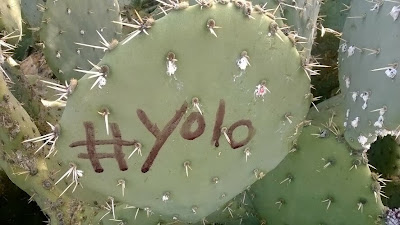

Left: Yucca Neon Sign in the Neon Museum Boneyard; Right: Pieces of the Stardust Sign
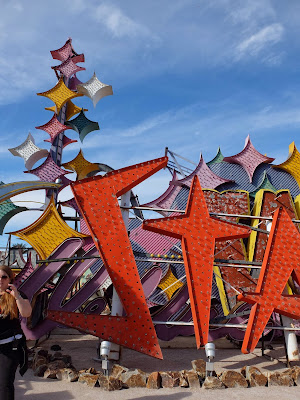
We took a tour of the Neon Museum boneyard, and among the many wonderful signs we saw was the “yucca” sign. Being botanical-themed, we just have to say something about it. In a previous post, Binomen Art- Yucca, we spelled out “yucca” in petals. No such thing here. Instead, the lettering isn’t the interesting part, rather, it’s the intricate curves of the neon tubing making up the stalk and flowers.
We wrote to the museum to get the story on the “yucca” sign - apparently, we were too busy photographing it to listen to the tour guide - and received this reply: “The Yucca Motel originally stood at 1727 South Las Vegas Blvd. The sign was designed and built by YESCO around 1950 and stood until the motel was demolished in 2010, at which point the sign was delivered to its new home here at the Neon Museum.”
If you are in Las Vegas, the Neon Museum boneyard tour is worth a visit.
Left: A Guide the Neon Museum Explains the Yucca Sign; Right: The “La Concha” Sign. (The former motel’s lobby is now the museum’s visitor center.)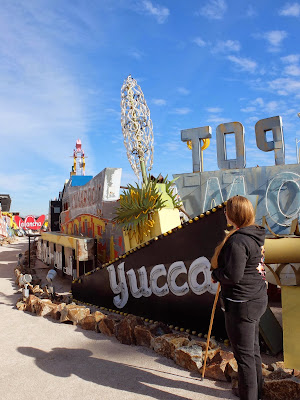

Neon Museum: Parts of Three Signs Together – Tropicana, Desert Inn, Silver Slipper.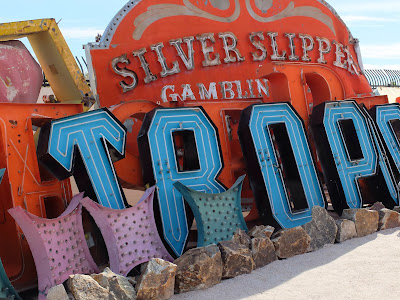
Faces in the L.A. Street Market Mural, Las Vegas

This mural is one of many on the L.A. Street Market building in Las Vegas. This images in this post are on a wall that faces the Neon Museum. In fact, the Neon Museum tour starts in a little courtyard which leaves you staring at two large faces in the mural.
This mural is by Andre Wilmore, known as “Dray”.



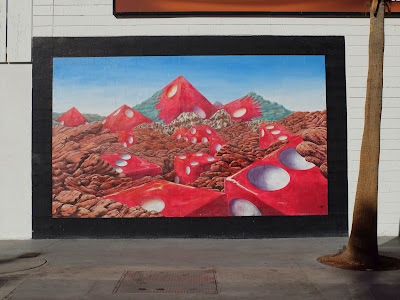
I’m not sure why, but we always end up passing by this mural on our way to the Fremont Experience. The mural is called the “Pyramid at Red Rock Canyon” by Ozzy Villate and is part of the Centennial Mural series commemorating Las Vegas’ 100th birthday (it was founded in 1905). The mural features a desert scene with dice. It’s part Daliesque, part candidate for a Pink Floyd album cover. It’s located at 200 Fremont Street.